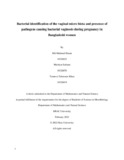| dc.contributor.advisor | Haque, Fahim Kabir Monjurul | |
| dc.contributor.advisor | Ahmed, Akash | |
| dc.contributor.advisor | Sultana, Jobaida | |
| dc.contributor.author | Hasan, Md Mahmud | |
| dc.contributor.author | Sultana, Mashyat | |
| dc.contributor.author | Khan, Tasnova Tabassum | |
| dc.date.accessioned | 2022-05-23T08:45:21Z | |
| dc.date.available | 2022-05-23T08:45:21Z | |
| dc.date.copyright | 2022 | |
| dc.date.issued | 2022-02 | |
| dc.identifier.other | ID 18326032 | |
| dc.identifier.other | ID 18326032 | |
| dc.identifier.other | ID 18326019 | |
| dc.identifier.uri | http://hdl.handle.net/10361/16655 | |
| dc.description | This thesis is submitted in partial fulfilment of the requirements for the degree of Bachelor of Science in Microbiology, 2022. | en_US |
| dc.description | Catalogued from PDF version of thesis. | |
| dc.description | Includes bibliographical references (pages 66-70). | |
| dc.description.abstract | Bacterial vaginosis is a one-of-a-kind upheaval of the complex vaginal bacterial flora with the absence of lactobacilli and the expansion of Gardnerella vaginalis, Atopobium vaginae, prevotella bivia, and resident anaerobic vaginal bacteria. Vaginosis is linked to preterm labor, early delivery, and preterm premature rupture of the membranes, amniotic fluid infection, postpartum endometritis, and post cesarean wound infections, as well as spontaneous abortion during pregnancy, according to recent studies. According to a recent study, 10-41 percent of women get bacterial vaginosis, which has been linked to maternal and fetal morbidity. Sociodemographic variables, previous health history, previous UTI and BV record, vaginal discharge, and weight have all been linked to variations in bacterial vaginosis prevalence rates. In this study, vaginal swab samples were taken from 50 patients and cultured it on HBT, Blood agar and MRS. The majority of the patients in the study (n=50) were young adults between the ages of 25 and 30, who had the highest average colony count in both HBT and Blood agar. In addition, patients from metropolitan regions had a higher risk of contracting bacterial vaginosis. Furthermore, 11 out of 50 patients had a prior UTI, and these patients had a higher average colony count of 135.54 and 28.63 for HBT and Blood agar, respectively, than those who did not have a prior UTI, but a very low average colony count of 37 for Lactobacillus species, which is lower than 52.70 for patients without a prior UTI, indicating that patients with a prior UTI have a higher risk of bacterial vaginosis. In addition, the majority of patients with vaginal discharge have higher average colony growth in HBT and Blood agar but lower average colony growth on MRS than patients without vaginal discharge, according to our findings. In conclusion, patients with higher Gardnerella vaginalis and Atopobium vaginae culture growth have lower growth for lactobacillus spp in our entire study is an indicator of bacterial vaginosis is consistent. | en_US |
| dc.description.statementofresponsibility | Md Mahmud Hasan | |
| dc.description.statementofresponsibility | Mashyat Sultana | |
| dc.description.statementofresponsibility | Tasnova Tabassum Khan | |
| dc.format.extent | 70 pages | |
| dc.language.iso | en | en_US |
| dc.publisher | Brac University | en_US |
| dc.rights | Brac University theses are protected by copyright. They may be viewed from this source for any purpose, but reproduction or distribution in any format is prohibited without written permission. | |
| dc.subject | Bacterial vaginosis | en_US |
| dc.subject | Bacterial identification | en_US |
| dc.subject | Pathogens | en_US |
| dc.subject | Pregnancy | en_US |
| dc.subject | Women | en_US |
| dc.subject.lcsh | Vaginosis, Bacterial -- diagnosis. | |
| dc.subject.lcsh | Pregnancy Complications, Infectious -- diagnosis. | |
| dc.title | Bacterial identification of the vaginal micro biota and presence of pathogens causing bacterial vaginosis during pregnancy in Bangladeshi women | en_US |
| dc.type | Thesis | en_US |
| dc.contributor.department | Department of Mathematics and Natural Sciences, Brac University | |
| dc.description.degree | B. Microbiology | |

